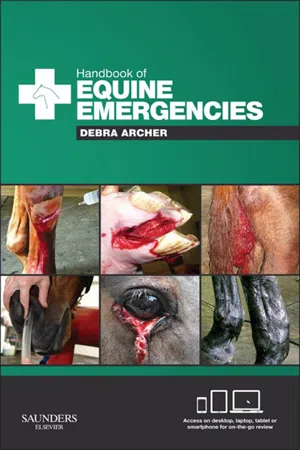
- 336 pages
- English
- ePUB (mobile friendly)
- Available on iOS & Android
Handbook of Equine Emergencies
About this book
There are approximately 5, 780 vets in the UK seeing horses regularly and 800 final year students per year studying equine. Equine emergencies (e.g. Musculoskeletal, Respiratory, Ophthalmic or Foal) are regular occurrences: most vets are not called out regularly enough to become specialists, but do need to know enough to treat these emergencies. The idea of this book is to be a quick practical reference guide that a vet could keep handy in such emergencies. Currently there are no other easy to use pocketbooks on this subject in the market.
The existing Equine Emergencies texts are either aimed at horse owners or are too detailed to be useful in this context, very large and include uncommon equine emergencies and advanced techniques that are irrelevant to the mixed practitioner.
- Suitable for all equine practitioners
- Concise and practical layout and content
- Accessible online downloads
Frequently asked questions
- Essential is ideal for learners and professionals who enjoy exploring a wide range of subjects. Access the Essential Library with 800,000+ trusted titles and best-sellers across business, personal growth, and the humanities. Includes unlimited reading time and Standard Read Aloud voice.
- Complete: Perfect for advanced learners and researchers needing full, unrestricted access. Unlock 1.4M+ books across hundreds of subjects, including academic and specialized titles. The Complete Plan also includes advanced features like Premium Read Aloud and Research Assistant.
Please note we cannot support devices running on iOS 13 and Android 7 or earlier. Learn more about using the app.
Information
The basics
General approach to dealing with equine emergencies






Table of contents
- Cover image
- Title page
- Table of Contents
- Copyright
- Preface
- Acknowledgements
- Dedication
- Abbreviations and symbols
- Chapter 1: The basics
- Chapter 2: Wounds and other integumentary emergencies
- Chapter 3: Musculoskeletal emergencies
- Chapter 4: Oral and gastrointestinal emergencies
- Chapter 5: Respiratory emergencies
- Chapter 6: Ophthalmic emergencies
- Chapter 7: Neurological emergencies
- Chapter 8: Reproductive emergencies
- Chapter 9: Urinary tract emergencies
- Chapter 10: Cardiovascular emergencies
- Chapter 11: Hepatic, endocrine and metabolic emergencies
- Chapter 12: Emergencies in foals
- Chapter 13: Emergencies in donkeys and mules
- Chapter 14: Iatrogenic emergencies
- Chapter 15: Infectious diseases
- Chapter 16: Poisoning, bites and stings
- Chapter 17: Other specific emergency situations
- Chapter 18: Other essentials
- Chapter 19: How to…
- Index